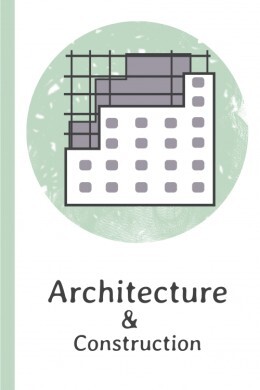Architektur und Bauwesen - Classical Architecture
Hier lernen Sie einige englische Wörter, die mit der klassischen Architektur zusammenhängen, wie "Arkade", "Mutulus" und "Bogen".
Überprüfen
Lernkarten
Rechtschreibung
Quiz

a round or drum-shaped architectural element that is often used for decorative purposes above doors or windows in buildings, or as a part of a dome

Trommel
a decorative element or symbol carved or inscribed onto a surface

Glyphe, dekoratives Symbol
a decorative element consisting of vertical rectangular blocks with three vertical grooves called glyphs

Triglyph, ein dekoratives Element
the triangular upper portion of the entrance of a building, often seen in buildings with Classical architecture

Giebel, dreieckiger Giebel
the horizontal, decorative element that rests on top of columns or pillars in architecture

Gebälk, Kranzgesims
a covered entrance or porch with columns, typically leading to the main entrance of a building and serving as a decorative architectural feature

Portikus, Säulengang
a system of architectural design based on specific proportions, column styles, and decorative elements derived from ancient Greek and Roman architecture

klassische Ordnung, klassischer Baustil
a long, open garden or promenade surrounded by covered colonnades or porticoes

Xystos, überdachter Spaziergang
the lowest horizontal element of a classical entablature, typically located above the columns and below the frieze

Architrav, der Architrav
a rectangular space or panel between the triglyphs in a Doric frieze, often decorated with relief sculptures or painted designs

Metope, rechteckiger Raum zwischen den Triglyphen
a horizontal band or section of an entablature in classical architecture, typically found in the Doric order, characterized by alternating triglyphs and metopes

dorischer Fries, dorisches horizontales Band
a style of ancient Greek architecture known for its simple, sturdy columns without decoration at the top

dorische Ordnung, dorischer Stil
an arch-covered passage along the side of a group of buildings

überdachter Durchgang, Bogengang
a columned porch or courtyard that surrounds a building or an open space, typically found in ancient Greek and Roman architecture

Peristyl, Säulengang
a covered walkway or colonnade in ancient Greek architecture, typically consisting of a long row of columns with a roof overhead

Stoa, Säulengang
a small, roofed theater or auditorium in ancient Greece and Rome used for musical performances, poetry readings, and other cultural events

Odeon, antikes Theater
a large, rectangular building with a central nave, side aisles, and often a raised apse at one end

Basilika, basilikales Gebäude
a room or gallery that is open in one or more sides, particularly one that is attached to a house and faces a garden on one side

Loggia, offene Galerie
the central chamber or inner sanctuary of a temple in classical architecture, where the cult statue or sacred objects were housed

Cella, Naos
a decorative motif in the form of stylized flower or leaf, typically used in ancient Greek and neoclassical architecture

Anthemion, Anthemion-Motiv
a series of arches or arcades that are supported by columns or piers, often used in architectural designs to create decorative openings or galleries

Arkatur
a decorative ribbon or scroll motif typically found in Renaissance and Baroque styles, often used to display inscriptions or decorative elements

Banderole
a double-curved molding profile featuring a concave upper curve and a convex lower curve, commonly used in classical and neoclassical architecture for decorative purposes

Zyma, doppelt geschwungenes Profil
a semicircular or rectangular recess in a building, often with seating, used for social gatherings or as a decorative architectural feature

Exedra, Apsis
the topmost platform or step of a classical Greek or Roman temple on which the columns are placed

Stylobat, oberste Plattform eines klassischen Tempels
a decorative element or molding that forms a projecting crown or cornice at the top of a structure, typically found in classical or neoclassical styles

Corona, dekorative Krone
an ornamental element placed on the apex or corners of a pediment or the top of a roof in classical architecture, typically depicting decorative figures or motifs

Akroter, dekoratives Akroter-Element
a small, often artificial, cave-like structure or enclosed space that is designed for aesthetic or functional purposes

Grotte, künstliche Höhle
a decorative block or projection that is typically found under the projecting eaves of a classical entablature

Mutulus, Modillon
one of the classical architectural orders characterized by slender, fluted columns with scroll-like capitals adorned with volutes

ionische Ordnung, ionischer Stil
a classical architectural order characterized by its ornate capital adorned with acanthus leaves, often used in grand and elaborate structures

Korinthische Ordnung, Korinthischer Stil
a decorative molding or projection that runs along the topmost part of a building's exterior wall, typically serving as a crowning element and providing a transition between the wall and the roof

Karnies, dekorative Leiste
a decorative element used in classical architecture to cover the joints between roof tiles and the eaves of a building, often featuring intricate designs or motifs

Antefix, architektonisches Dekorelement
a decorative pattern in architecture that features alternating oval shapes and V-shaped forms used in molding or friezes
an open central courtyard or open space, often with a skylight, that is surrounded by a building or enclosed by walls, commonly found in ancient Roman architecture

Atrium, Innenhof
an open building that is round or oval in shape and has a space in the middle surrounded by several seats, originated in ancient Roman and Greek architecture used for public entertainments such as sports or drama

Amphitheater, Arena
a simplified form of classical architectural order characterized by a plain and unadorned column with a simple capital and base

Toskanische Ordnung, Toskanischer Stil
a curved symmetrical structure that supports the weight above it, used in bridges or buildings

Bogen, Gewölbe
| Architektur und Bauwesen |
|---|